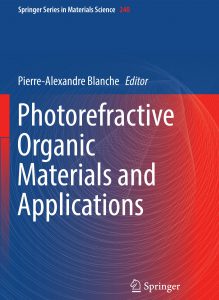Review Article

10/04/2021: P.-A. Blanche, J.-W. Ka, N. Peyghambarian, “Review of Organic Photorefractive Materials and Their Use for Updateable 3D Display“, materials (MDPI), Materials 2021, 14, 5799. Link
In this article we are reviewing:
- The photorefractive effect.
- The specific characteristics for a material to be used in 3D display.
- The different molecules found in photorefractive polymers.
- How to make samples for holographic display.
- The setup to record and display 3 color holographic 3D stereograms.


 12/17/2018 P.-A. Blanche, “
12/17/2018 P.-A. Blanche, “
 Guest Editor for MDPI Materials, special issue on “
Guest Editor for MDPI Materials, special issue on “
 09/01/16: Invited speaker at the SPIE “Organic Photonics + Electronics” symposium. “Light Manipulating Organic Materials and Devices III” conference.
09/01/16: Invited speaker at the SPIE “Organic Photonics + Electronics” symposium. “Light Manipulating Organic Materials and Devices III” conference.